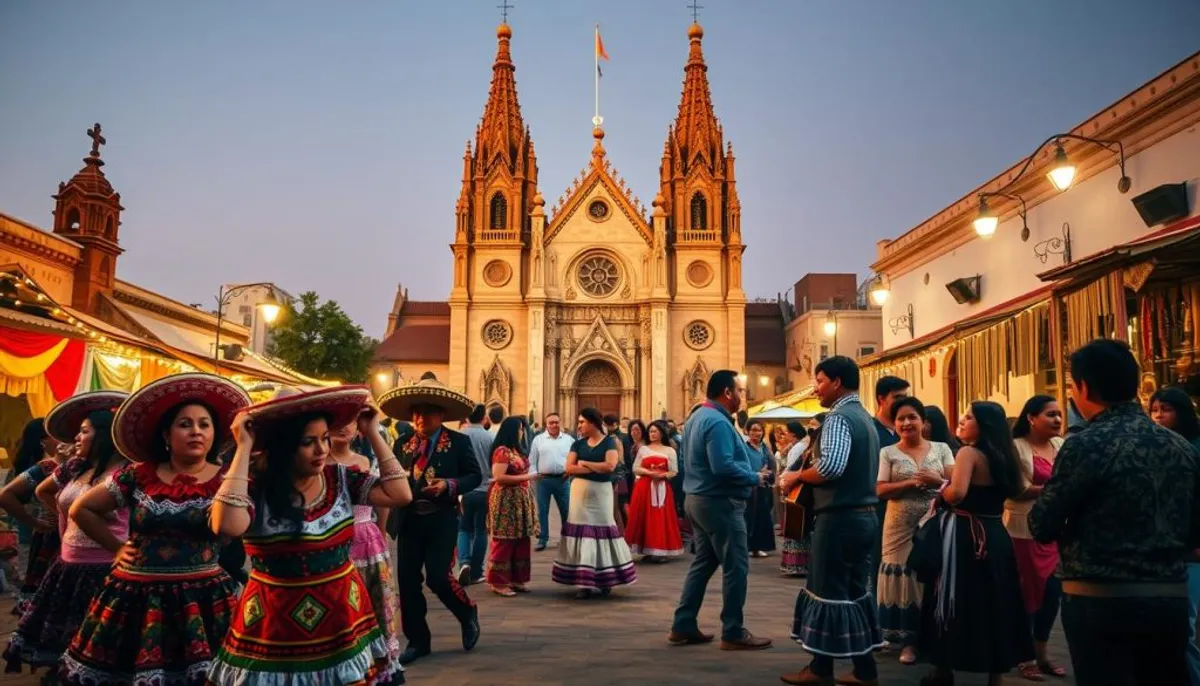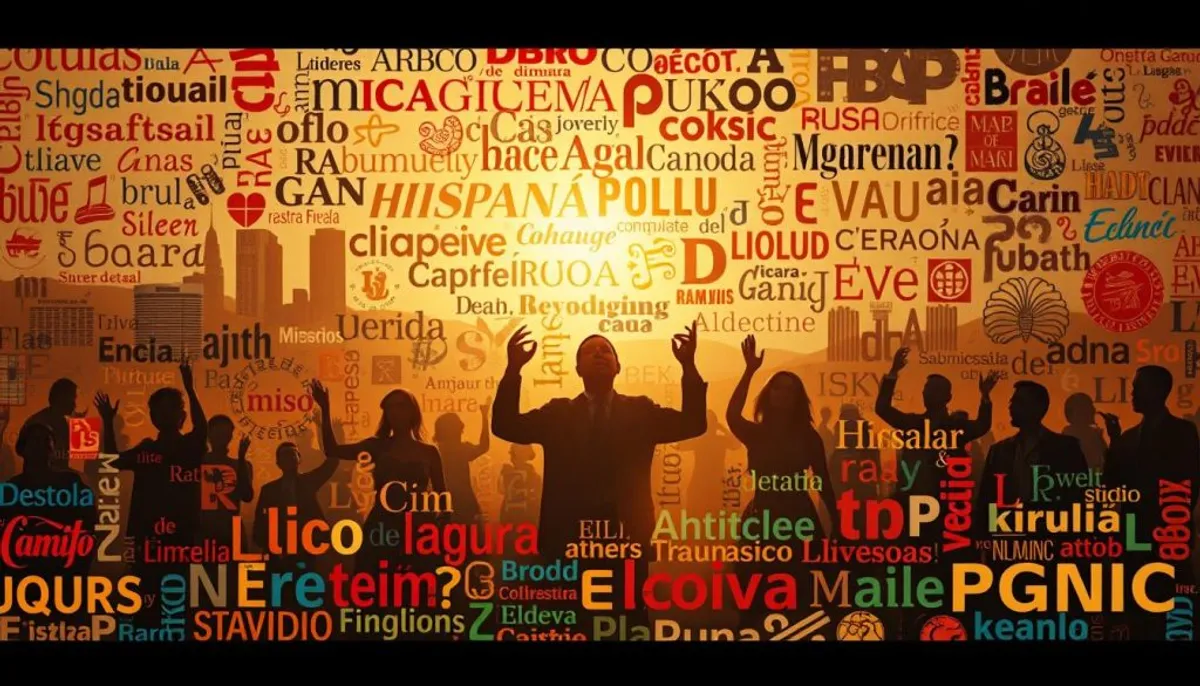The Hispanic culture represents a true living treasure, where millennia of history intertwine with vibrant modernity. Its unique identity manifests through its traditions, art, and language. This richness attracts millions of curious visitors each year.

Spain, the cradle of this culture, shines with its diversity. It is the second most popular tourist destination in the world, welcoming over 58 million visitors each year. Its beaches, monuments, and festivities significantly contribute to its GDP, representing 11% of it.
The richness of Hispanic culture is also expressed through its products. Spain is the world's largest producer of olive oil and a major exporter of wine. Its varied gastronomy reflects the influence of the many peoples who have shaped its history.
The Spanish language, spoken by over 550 million people in 90 countries, is a pillar of this culture. It unites diverse communities, from Latin America to the United States. Indeed, 30% of the American population will be of Hispanic origin by 2050.
The Hispanic Historical and Architectural Heritage
The Hispanic heritage is a goldmine for architecture and history enthusiasts. With over 50 UNESCO sites, Spain presents itself as a true journey through time. This country, fifth in the world for the number of UNESCO sites, invites deep and fascinating cultural exploration.
The UNESCO Sites and Historical Monuments
From the splendor of the Altamira cave paintings to the ingenuity of the Segovia aqueduct, Spain reveals its history. The Cathedral of León, classified as a national monument since 1844, illustrates the magnificence of Spanish architectural heritage. The protection of these treasures has undergone remarkable evolution, from the royal ordinance of 1803 to the 1985 law on Spanish historical heritage.
Moorish and Christian Architecture
The Alhambra in Granada and the mosque of Córdoba are testimonies of Moorish influence. The cathedrals of Seville, Burgos, and the Sagrada Familia in Barcelona embody Christian heritage. This architectural diversity reflects the richness of Hispanic traditions, which have shaped the Iberian Peninsula.
The Iconic Museums
Spanish museums are hidden treasures. Since 1911, the archaeological excavation law has regulated the conservation of antiquities. These institutions preserve and exhibit Hispanic art and history, offering a journey through the ages. Contemporary heritage, recognized since the 1980s, enriches this already impressive collection.
Hispanic Culture: A Millennial Heritage
The Hispanic culture, deep and rich, far exceeds the geographical limits of Spain. With over 500 million speakers, Spanish ranks second in the world in terms of spoken language, after Mandarin. This linguistic preeminence illustrates the scope of Hispanic history and its global influence.
The Hispanic cultural heritage unfolds across various fields. Spain, with 49 UNESCO sites and around 17,000 historical monuments, showcases the depth of its heritage. These figures highlight the architectural and artistic richness of the country, the fruit of a millennia-old history.
The Hispanic traditions are extremely varied, reflecting regional diversity. This diversity manifests in art, literature, music, and gastronomy. For example, Andalusian flamenco and traditional Basque dances each reflect the unique identity of their region.
| Aspect | Figure |
|---|---|
| Spanish speakers worldwide | Over 500 million |
| Spanish UNESCO sites | 49 |
| Monuments classified in Spain | Approximately 17,000 |
| Museums and collections in Spain | Over 1,600 |
Hispanic history continues to influence modern research. Recent studies examine the role of women in medieval Iberian societies. They challenge stereotypes about their marginalization. These studies enrich our understanding of Hispanic culture and its evolution over the centuries.
The Arts and Creative Expression
The Hispanic culture shines through its arts, offering a rich and varied array. Painting, literature, and music stand out, profoundly influencing history and the artistic world. This Hispanic creative expression has left a lasting imprint.
Painting and Great Hispanic Masters
Hispanic painting is rich in exceptional talents. El Greco, Murillo, and Velázquez founded an unparalleled pictorial tradition. Velázquez, with “Las Meninas,” continues to fascinate with its mysteries. Goya dominated the 18th century, while Dalí, Picasso, and Miró revolutionized art in the 20th century.
Hispanic Literature
The Hispanic literature is distinguished by its diversity and depth. From the classics of Cervantes to contemporary writers, it explores universal themes. Hispanic writers have skillfully combined realism and fantasy, creating a unique and appreciated literary style.
Hispanic Music
The Hispanic music is a treasure of rhythms and melodies. From Andalusian flamenco to Latin American rhythms, it expresses passion and joy of life. Traditional dances, such as Argentine tango and Cuban salsa, have gained worldwide popularity, illustrating the vitality of this musical culture.
| Period | Artist | Iconic Work |
|---|---|---|
| 16th Century | El Greco | View of Toledo |
| 17th Century | Velázquez | Las Meninas |
| 18th Century | Goya | The Naked Maja |
| 20th Century | Picasso | Guernica |
Living Traditions and Festivities
The Hispanic culture is distinguished by its living traditions and colorful festivities. These celebrations reflect Hispanic identity and enliven the streets year-round. From religious holidays to exuberant carnivals, each event tells a unique story.
Popular and Religious Festivals
Spain has about 14 national holidays, each with profound cultural significance. Semana Santa attracts millions of visitors, especially in Seville, where the spectacular processions capture international attention. The Day of the Three Kings, on January 5 and 6, features colorful parades in Spanish cities.
Carnivals and Regional Celebrations
Carnivals and regional festivals showcase the diversity of Hispanic traditions. The Haitian tradition, like these events, illustrates cultural richness and joy of life. The Feria de Abril in Seville welcomes over 1.5 million visitors over six days. La Tomatina in Buñol, with its 20,000 participants, has become a global phenomenon. These events blend cultural heritage and joy of living.
| Festival | Location | Participants |
|---|---|---|
| Feria de Abril | Seville | 1.5 million |
| San Fermín | Pamplona | 1 million |
| Tomatina | Buñol | 20,000 |
Flamenco and Traditional Dances
Flamenco, a vibrant expression of Hispanic identity, captivates the entire world. In 70% of Spanish celebrations, groups of wandering musicians animate the streets, highlighting the importance of music in Hispanic culture. These danced traditions embody the soul and passion of the Spanish people.

These festivities are not mere entertainment. They are the beating heart of Hispanic culture, uniting generations and preserving a millennial heritage. Each festival, each dance, each note of music tells the story of a people proud of its roots and looking towards the future.
Hispanic Gastronomy
The Hispanic cuisine is a true culinary treasure, reflecting the history and cultural diversity of the region. It draws its roots from a rich heritage, influenced by Romans, Arabs, and Native Americans. This unique fusion has created a palette of unique flavors, making Hispanic gastronomy one of the most appreciated in the world.
Spain, the cradle of this cuisine, stands out for its exceptional products. The country is the world's largest producer of olive oil, with over 250 varieties. Spanish vineyards, covering more than a million hectares, make it the leading wine-producing country in the world. These quality ingredients are at the heart of Hispanic culture and its culinary traditions.
Tapas and paella are the most well-known ambassadors of this cuisine. But Hispanic gastronomy does not stop there. Iberian ham, especially the prestigious bellota bellota, is an emblematic product. Canned fish and seafood are also popular specialties.
The international recognition of Hispanic cuisine is undeniable. With around 300 Michelin-starred restaurants in Spain, several of which rank among the best in the world, Hispanic gastronomy has risen to the top of culinary art. Chefs like Ferran Adrià and Dabiz Muñoz have significantly contributed to this worldwide fame.
Regional diversity is another asset of Hispanic cuisine. Each of Spain's 17 autonomous regions has its specialties, offering a culinary journey across the country. From cocido madrileño to fabada asturiana, and ensaimada from Mallorca, each dish tells a story and perpetuates Hispanic traditions.
The Linguistic Influence and Cultural Diversity
The Hispanic diversity is manifested by the linguistic richness of Spain. Castilian, the official language, coexists with other regional languages. This coexistence creates an unparalleled cultural mosaic.
The Regional Languages and Their Preservation
In Spain, several regional languages play a crucial role. Catalan is spoken in the Balearic Islands and Catalonia. Galician is present in Galicia, while Basque is used in the Basque Country and Navarre. These languages are essential to Hispanic identity and require special attention for their preservation.

Cultural Mixing
The Hispanic culture results from a rich mixing. About 25% of the Spanish population has immigrant origins. This diversity enriches the social fabric. Cultural festivals, such as La Tomatina, attract millions of participants each year.
The Heritage in the Modern World
The influence of Hispanic culture far exceeds Spanish borders. With over 500 million speakers, Spanish is the second most spoken language. This global presence is evident in media, music, and cinema. Artists like Bad Bunny and Rosalía dominate international charts. Spanish-language films, such as “Pan's Labyrinth,” gain worldwide recognition, reinforcing Hispanic identity on an international scale.
The Contemporary Hispanic Way of Life
The Hispanic culture is constantly evolving, blending centuries-old traditions with modern innovations. Spain, the cradle of this rich identity, surprises with its mix of heritage and modernity.
In the culinary field, Spain shines. As the world's leading producer of olive oil, the country promotes its products through bold marketing initiatives. San Sebastián, a true gastronomic paradise, is home to numerous tapas bars and three Michelin three-star restaurants, including the famous Arzak, awarded since 1989.
Contemporary Hispanic fashion reflects this fusion of tradition and innovation. Major cities like Barcelona and Madrid host prestigious fashion weeks. Barcelona stands out for its avant-garde style, while Madrid combines haute couture with elegant ready-to-wear. The Balearic Islands, especially Ibiza, offer chic and casual fashion, perfectly suited to their paradisiacal setting.
Modern Spanish architecture is also impressive. Cutting-edge buildings, designed by renowned architects, combine aesthetics and functionality, embodying the innovative spirit of Hispanic culture.
| Aspect | Characteristic | Example |
|---|---|---|
| Gastronomy | Fusion of tradition and innovation | Michelin-starred restaurants in San Sebastián |
| Fashion | Stylistic diversity | Avant-garde in Barcelona, elegance in Madrid |
| Architecture | Contemporary design | Functional avant-garde buildings |
This contemporary Hispanic way of life, combining Hispanic traditions and modernity, continues to fascinate and influence the entire world, testifying to the vitality and adaptability of this rich and diverse culture.
Conclusion
The Hispanic culture, with its millennial heritage, continues to captivate and inspire the globe. It spans from historical conquests to artistic influences, touching all aspects of our lives. This cultural diversity is palpable every day.
The Hispanic heritage, shaped by centuries of complex history, manages to maintain its authenticity while adapting to the modern era. From vibrant festivities to distinctive culinary flavors, to globally recognized literature, Hispanic culture presents a rich panorama of living traditions.
Today, this culture continues to shine internationally. Whether through music, dance, or the way of life, the Hispanic heritage enriches our globalized world. It invites exploration of its diversity, proving that its influence remains relevant and inspiring.
RelatedRelated articles


